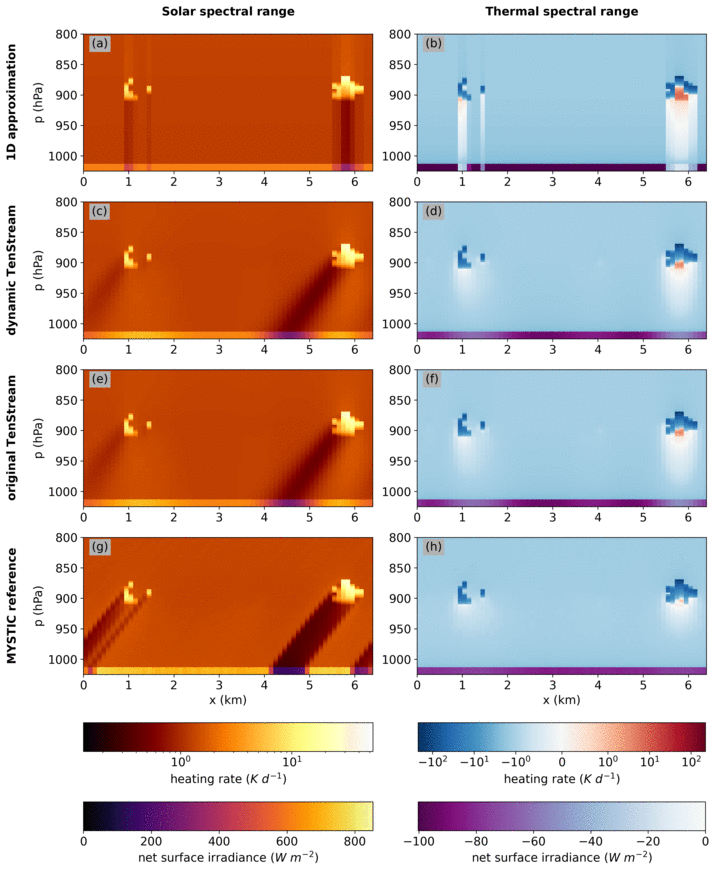Treating radiation like advection: A new approach to accelerate 3D radiative transfer in subkilometer-scale numerical weather prediction models
27.05.2024
Weather forecasts are based on numerical models that use an enormous amount of computing power to predict the weather for the coming days. One component of these weather models are radiative transfer models, which describe the transport of solar and thermal radiation through Earth’s atmosphere. To save computing time, this transport is still approximated so that radiation only propagates vertically, i.e. upwards and downwards, but not sideways. As a result, the shadows of clouds, for example, are always cast directly below them and not positioned according to the angle of solar incidence. While this assumption may have been reasonable in weather models with several kilometers of horizontal resolution, it is starting to reach its limits. This is because the higher the horizontal resolution of the weather models, the more important the interaction with neighboring grid cells in the model becomes for radiative transfer.
To efficiently calculate this 3D radiative transport, we developed the dynamic TenStream solver (Maier et al., 2024). It is based upon the TenStream solver (Jakub and Mayer, 2015) also developed here at the Meteorological Institute. Compared to other 3D models, the speed-up of the dynamic TenStream solver is mainly achieved by two means: First, radiation is not calculated from scratch at every time step of the numerical model anymore. Instead, the model uses the previously calculated result as the starting point of the new solution. Secondly, the dynamic TenStream model is based on incomplete solves, performing just the first few steps of an iterative scheme towards convergence very time it is called. Technically, these two approaches put radiation much closer to the transport of meteorological variables with the wind (advection), thus making it more similar to other components of the weather model.
To test our new dynamic TenStream model, we applied it to a precomputed shallow cumulus cloud time series. We compared the results of our new model to those of three other, well-established radiative transfer models: a 1D approximation as it is still used in all of today’s weather models, the original TenStream solver our new model is based on, and the Monte Carlo Model MYSTIC, which serves as a reference model. Calculations performed with this reference model took more than a factor of 1000 more computational time than calculations performed with the 1D model. Using vertical cross-sections through the model domain, the video below illustrates the behavior of the four solvers across time for both the solar (left) and thermal (right) spectral ranges. The values shown in the individual panels are heating rates, which describe sources and sinks of radiative energy in the atmosphere. In the solar spectral range, for example, you can see clouds, which are characterized by high heating rates (the white spots in the plots), and the shadows cast by them, which are characterized by low heating rates. You can see that the 1D solver visualized in panel (a) does not allow for horizontal transport of radiation. Thus, shadows in this panel are falsely cast directly below the clouds and do not follow the angle of solar incidence. The original TenStream solver depicted in panels (e) and (f) is visually much closer to the reference solution in (g) and (h), but also requires at least a factor of five more computing time. Most importantly for this article, however, panels (c) and (d) show the results for the new dynamic TenStream solver. Notably, its panels are updated less frequently than all the other panels. We do this because at this larger radiation time step, the computational effort of the dynamic TenStream model in panels (c) and (d) is comparable to that of the 1D model in (a) and (b). Nevertheless, our new solver leads to results that are much closer to the MYSTIC reference solution and hardly to distinguish from the original TenStream solution – apart from a few small details.
If you want to learn more about these details and everything else related to our new dynamic TenStream solver, feel free to read our recently published article in the Geoscientific Model Development (GMD) journal (reference below).

References:
- Maier, R., Jakub, F., Emde, C., Manev, M., Voigt, A., and Mayer, B.: A dynamic approach to three-dimensional radiative transfer in subkilometer-scale numerical weather prediction models: the dynamic TenStream solver v1.0, Geosci. Model Dev., 17, 3357–3383, https://doi.org/10.5194/gmd-17-3357-2024, 2024.
- Jakub, F. and Mayer, B.: A three-dimensional parallel radiative transfer model for atmospheric heating rates for use in cloud resolving models – The TenStream solver, J. Quant. Spectrosc. Ra., 163, 63–71, https://doi.org/10.1016/j.jqsrt.2015.05.003, 2015.

